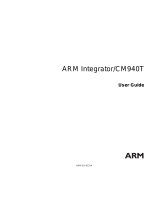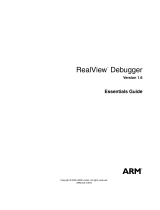Page is loading ...

ARM DUI 0114A
ARM710T Header Card
(KPI-0032A)
User Guide

ii
© Copyright ARM Limited 1999. All rights reserved.
ARM DUI 0114A
ARM710T Header Card
User Guide
© Copyright ARM Limited 1999. All rights reserved.
Release information
Proprietary notice
ARM, the ARM Powered logo, Thumb and StrongARM are registered trademarks of ARM Limited.
The ARM logo, AMBA, PrimeCell, Angel, ARMulator, EmbeddedICE, ModelGen, Multi-ICE,
ARM7TDMI, ARM7TDMI-S, ARM9TDMI, TDMI and STRONG are trademarks of ARM Limited.
Document confidentiality status
This document is Open Access. This document has no restriction on distribution.
Product status
The information in this document is Final (information on a developed product).
ARM web address
http://www.arm.com
Change history
Date Issue Change
27th April 1999 A Release
A
ll
ot
h
er pro
d
ucts or serv
i
ces ment
i
one
d
h
ere
i
n may
b
e tra
d
emar
k
s o
f
t
h
e
i
r respect
i
ve owners.
Neither the whole nor any part of the information contained in, or the product described in, this document may
be adapted or reproduced in any material form except with the prior written permission of the copyright
holder.
The product described in this document is subject to continuous developments and improvements. All
particulars of the product and its use contained in this document are given by ARM Limited in good faith.
However, all warranties implied or expressed, including but not limited to implied warranties or
merchantability, or fitness for purpose, are excluded.
This document is intended only to assist the reader in the use of the product. ARM Limited shall not be liable
for any loss or damage arising from the use of any information in this document, or any error or omission in
such information, or any incorrect use of the product.

iv
© Copyright ARM Limited 1999. All rights reserved.
ARM DUI 0114A
About this document
This document is the ARM710T Header Card User Guide.
Intended audience
This document has been written for experienced hardware and software engineers who
wish to use an ARM710T header card, with their ARM development board, for code
development and evaluation.
Organization
This document is organized into the following chapters:
Chapter 1 Overview of the ARM710T Header Card
Read this chapter for an introduction to the ARM710T Header Card.
Chapter 2 Setting up your System
Read this chapter for a description of how to set up the ARM
development board to work with the ARM710T Header Card.
Chapter 3 Configuring the ARM710T Header Card
Read this chapter for a description of how to configure the ARM710T
Header Card.
Chapter 4 Circuit Descriptions
Read this chapter for a description of the circuit board of the
ARM710T Header Card.
Typographical conventions
The following typographical conventions are used in this document:
bold Highlights ARM processor signal names within text, and interface
elements such as menu names. May also be used for emphasis in
descriptive lists where appropriate.
italic Highlights special terminology, cross-references and citations.
typewriter Denotes text that may be entered at the keyboard, such as
commands, file names and program names, and source code.

ARM DUI 0114A
© Copyright ARM Limited 1999. All rights reserved.
v
typewriter Denotes a permitted abbreviation for a command or option. The
underlined text may be entered instead of the full command or
option name.
typewriter italic
Denotes arguments to commands or functions where the argument
is to be replaced by a specific value.
typewriter bold
Denotes language keywords when used outside example code.

vi
© Copyright ARM Limited 1999. All rights reserved.
ARM DUI 0114A
Further reading
This section lists publications by ARM Limited.
ARM publications
For additional information, refer to the following:
• ARM Target Development System User Guide (ARM DUI 0061).
• ARM Multi-ICE User Guide (ARM DUI 0048).
• ARM Multi-ICE Installation Guide (ARM DSI 0005).
• ARM Software Development Toolkit User Guide (ARM DUI 0040).
• ARM710T Datasheet (ARM DDI 0086).

ARM DUI 0114A
© Copyright ARM Limited 1999. All rights reserved.
vii
Feedback
ARM Limited welcomes feedback both on the ARM710T header card, and on the
documentation.
Feedback on this document
If you have any comments on this document, please send email to
giving:
• the document title
• the document number
• the page number(s) to which your comments refer
• a concise explanation of your comments.
General suggestions for additions and improvements are also welcome.
Feedback on the ARM710T header card
If you have any comments or suggestions about this product, please contact your
supplier giving:
• the product name
• a concise explanation of your comments.

viii
© Copyright ARM Limited 1999. All rights reserved.
ARM DUI 0114A

ARM DUI 0114A
© Copyright ARM Limited 1999. All rights reserved.
ix
Contents
ARM710T Header Card User Guide
Preface
About this document ......................................................................................................iv
Further reading...............................................................................................................vi
Feedback ......................................................................................................................vii
Chapter 1 Overview of the ARM710T Header Card
1.1 Introduction to the ARM710T header card....................................................1-2
1.2 Board layout..................................................................................................1-3
Chapter 2 Setting up your System
2.1 Setting up your ARM development board.....................................................2-2
2.2 Debugging using Angel.................................................................................2-4
2.3 Debugging using Multi-ICE...........................................................................2-5
2.4 Debugging using EmbeddedICE...................................................................2-6
Chapter 3 Configuring the ARM710T Header Card
3.1 Setting the core clock frequency...................................................................3-2
3.2 Surface mount links ......................................................................................3-4
3.3 Using the external clock input.......................................................................3-5
3.4 Setting the bus clocking mode......................................................................3-6
3.5 Setting the endianness .................................................................................3-7

x
© Copyright ARM Limited 1999. All rights reserved.
ARM DUI 0114A
Chapter 4 Circuit Descriptions
4.1 The header card circuit board....................................................................... 4-2
4.2 Connectors................................................................................................... 4-4
Index

Overview of the ARM710T Header Card
1-2
© Copyright ARM Limited 1999. All rights reserved.
ARM DUI 0114A
1.1 Introduction to the ARM710T header card
The ARM710T header card (part number KPI-0032A) is a processor daughter board for
the ARM development board (HBI-0011B). This guide describes how to set up your
ARM development board and ARM710T header card.
The header card and development board combination provides a suitable platform for
code development and evaluation of the ARM710T processor.
Together with the ARM Software Development Toolkit, the user can download, execute
and debug code. This can be with either the Multi-ICE debugging system, available
separately from ARM, or the Angel debug monitor.
1.1.1 System requirements
To use the ARM710T header card you will need the following:
• ARM development board (HBI-0011B)
• ARM debugger, such as:
• Multi-ICE (recommended)
•Angel.
• ARM Software Development Toolkit.
1.1.2 Features of the ARM710T header card
The main features of the ARM710T header card are:
• selectable core frequency up to 40MHz
• logic analyzer connectors for every signal of the ARM710T
• Multi-ICE connector for debugging using the EmbeddedICE macrocell.

Overview of the ARM710T Header Card
ARM DUI 0114A
© Copyright ARM Limited 1999. All rights reserved.
1-3
1.2 Board layout
Figure 1-1 shows the layout of the main components of the ARM710T header card.
Figure 1-1 Board layout
1.2.1 Schematic diagrams
The complete set of schematic diagrams for the ARM710T header card is supplied in
pdf format on the accompanying disk.
POD2
POD1
POD4
POD6
POD5
POD3
PL4
PL1
PL2
PL3
ARM710T
S1
SK5
ARM logo
GND
CLK
2X
EX
SEL0
SEL1
SEL2
nPD
LK5
LK4
Link 4
Link 5
PL5
PL6
POD7
POD8

Overview of the ARM710T Header Card
1-4
© Copyright ARM Limited 1999. All rights reserved.
ARM DUI 0114A

ARM DUI 0114A
© Copyright ARM Limited 1999. All rights reserved.
2-1
Chapter 2
Setting up your System
This chapter describes how to set up your ARM development board to work with the
ARM710T header card and gives details of connecting debuggers. It contains the
following sections:
• Setting up your ARM development board on page 2-2
• Debugging using Angel on page 2-4
• Debugging using Multi-ICE on page 2-5
• Debugging using EmbeddedICE on page 2-6.

Setting up your System
2-2
© Copyright ARM Limited 1999. All rights reserved.
ARM DUI 0114A
2.1 Setting up your ARM development board
The ARM710T header card plugs into the top left hand corner of the development
board, with the ARM logo on the silk-screen positioned as shown in Figure 2-1, so that
the header is flush with the development board. The correct way to mount the header
card is shown in Figure 2-1.
Figure 2-1 Mounting the header card
The ARM710T can be debugged using one of the following:
• Multi-ICE debugging system (available separately)
• EmbeddedICE debugging system (available separately)
• Angel debug monitor (supplied with the ARM development board).
Note
EmbeddedICE can be used to debug an ARM710T but does not support debugging with
the caches on.
ARM logo
ARM
development
board
ARM710T
header card

Setting up your System
ARM DUI 0114A
© Copyright ARM Limited 1999. All rights reserved.
2-3
2.1.1 Setting the bus clock frequency
The ARM710T header card requires the bus clock frequency, BCLK, of the board to
be set to 4, 8, 16 or 20MHz. This is set by changing the FREQ SELECT switch, S1, on
the ARM development board, shown in Figure 2-2.
Figure 2-2 Position of switch S1
Table 2-1 shows the switch settings for the allowable bus clock frequencies.
Note
Do not select any combination other than shown in the table.
ARM development board
ARM740T
header card
12
FREQ
SELECT
S1
Switch settings for 20 MHz
bus clock shown.
Table 2-1 Bus clock settings
Position 4 Position 3 Position 2 Position 1 BCLK (MHz)
On On On On 4
On On On Off 8
On On Off On 16
On On Off Off 20

Setting up your System
2-4
© Copyright ARM Limited 1999. All rights reserved.
ARM DUI 0114A
2.2 Debugging using Angel
Angel is a program that enables rapid development and debugging of applications
running on ARM-based hardware. Angel runs on the ARM development board or a
development version of the product hardware alongside your application. It
communicates with a debugger that can handle the Angel communications protocol,
such as the ARM Debugger for Windows, or armsd. A serial/parallel or ethernet
connection to the host debugging system is required.
The binary image for the Angel is supplied with the ARM development board. To
download, execute and debug code the host needs to be running the ARM Debugger for
Windows or armsd program supplied as part of the ARM Software Development Toolkit,
available separately from ARM.
Note
If debugging with Angel is required, jumper links on the ARM development board may
need to be changed. Please refer to the manual ARM Target Development System User
Guide for details of how to establish a debug link between the board and the host system.

Setting up your System
ARM DUI 0114A
© Copyright ARM Limited 1999. All rights reserved.
2-5
2.3 Debugging using Multi-ICE
The Multi-ICE debugging system provides a nonintrusive debugging system with fast
download and is available separately from ARM.
The ARM710T header card provides Multi-ICE connector, PL5, which connects via a
20-way ribbon cable to the Multi-ICE hardware. The Multi-ICE server and debugger
software should be run on the host computer. Please refer to the Multi-ICE Installation
Guide for software installation instructions and the Multi-ICE User Guide for use of the
Multi-ICE software.
The debugging system should be set up as shown in Figure 2-3.
Figure 2-3 Multi-ICE debugging system
Note
Debugger and Multi-ICE server can be the same machine or two networked machines.
Multi
ICE
ARM development board
FREQ
SELECT
S1
Power supply
P8, P9
DebuggerMulti-ICE serverMulti-ICE hardware
20-way JTAG cable
Network
25-way cable
BCLK frequency settings

Setting up your System
2-6
© Copyright ARM Limited 1999. All rights reserved.
ARM DUI 0114A
2.4 Debugging using EmbeddedICE
Debugging using EmbeddedICE is not recommended because EmbeddedICE does not
support debugging with the caches on.
/








